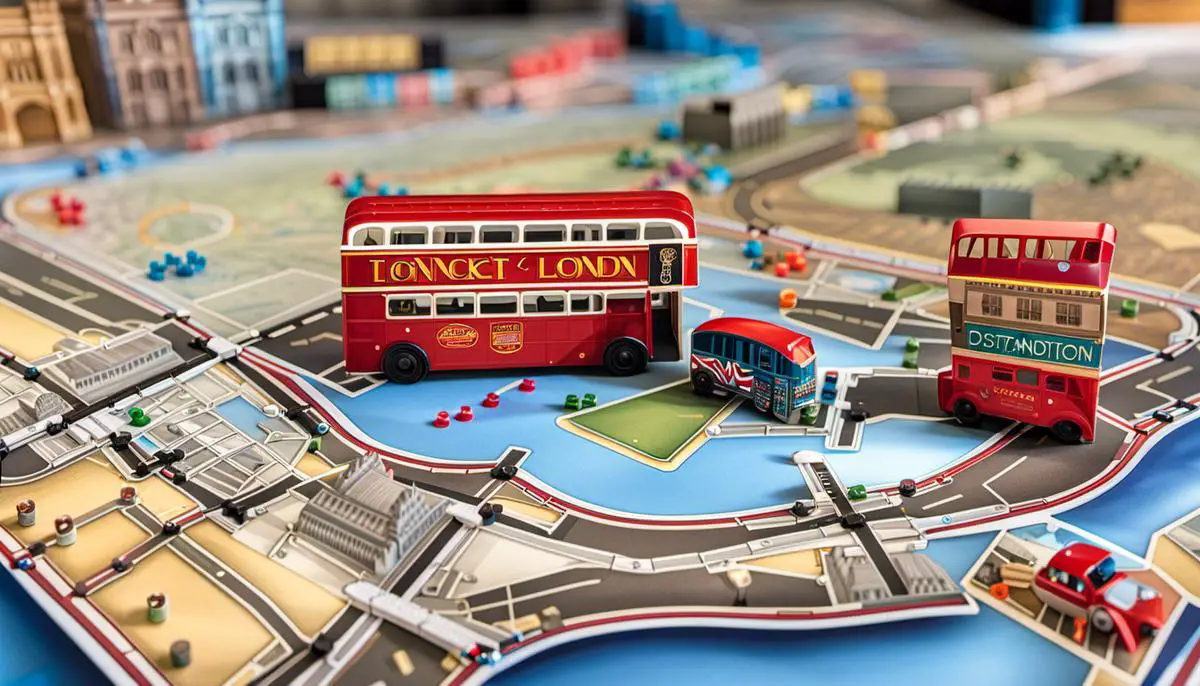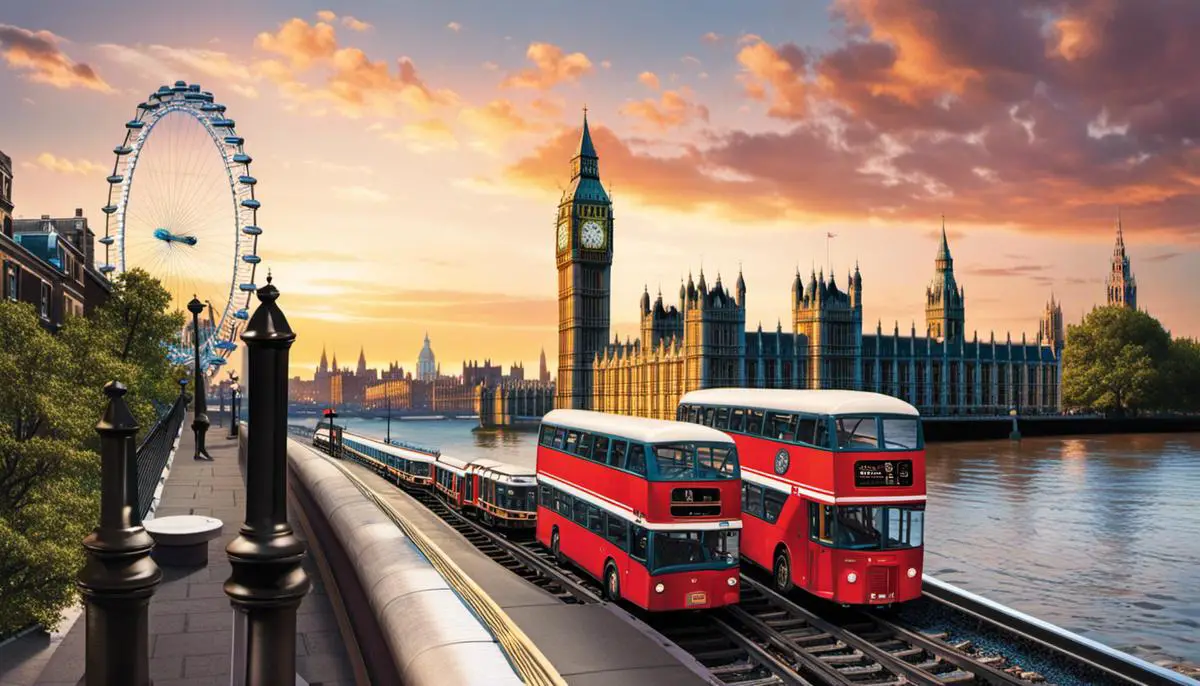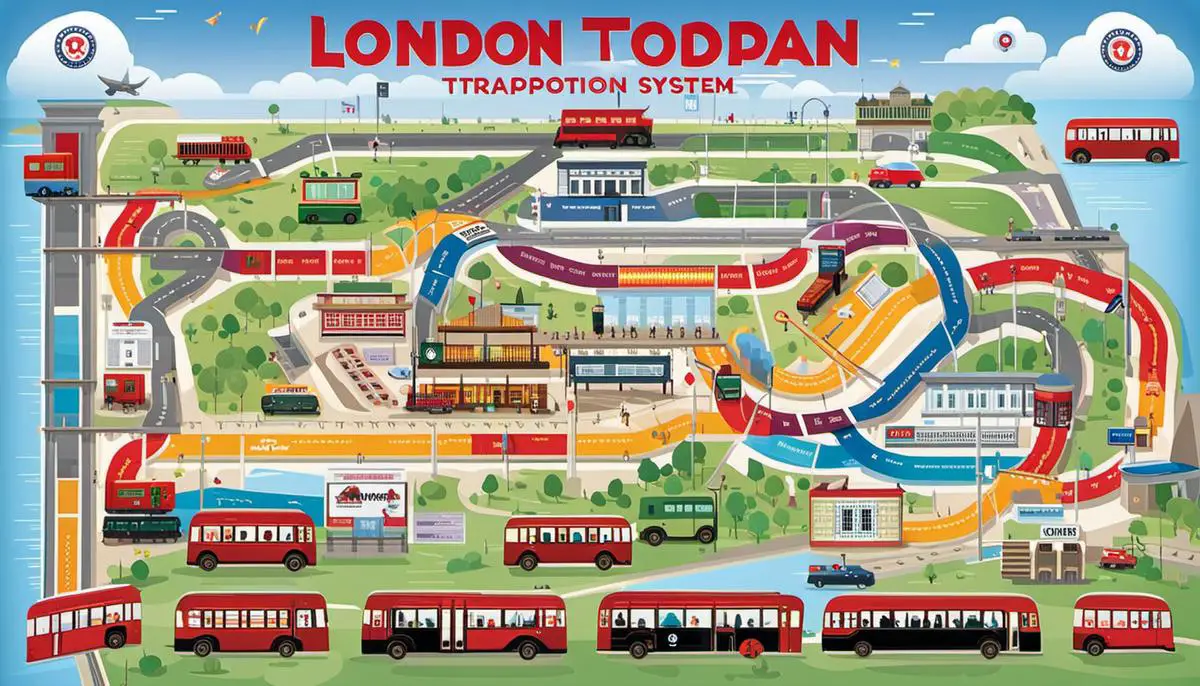For a thrilling blend of strategy, competition, and a fun encounter with the iconic sights of England’s capital, look no further than the board game Ticket to Ride London. Embracing the challenge to navigate London’s venerable transportation system, participants vie to score the highest points by claiming routes, fulfilling destination tickets, and linking buses in continuous paths. This essay equips you with an in-depth understanding of the game pieces, clear comprehension of the rules and objectives, effective strategy formation, and immersive practice tactics. Together, these key elements craft a roadmap that can transform an enthusiastic beginner into a masterful player.
Understanding the Game Components
Understanding the Board Map: The essence of London Transport System
The board map is a representation of London’s transport system, featuring essential locations and routes that players will need to connect using their buses. It’s color-coded to match the transportation cards and features different routes between specific locations. By placing their buses on these routes and connecting two locations, players can score points.
Familiarizing with Transportation Cards: The key to conquering routes
Transportation cards are what players gather and utilize to claim the routes on the board map. Each of these cards corresponds to a color that matches the color of the routes on the board. To claim a route, you need to have a number of transportation cards of the same color that matches the length of the route you wish to claim. The cards include colors such as blue, red, black, green, and others, plus multicolored wild cards that can serve as any color.
Mastering the use of Destination Tickets: Essential for scoring points
Destination tickets are cards that depict two locations on the board that you need to connect using your buses. Each ticket has a point value that is added to a player’s score if they successfully connect the two locations by the end of the game. However, failing to do so will cause the card’s point value to be subtracted from their score. So choose your destination tickets wisely.
Deploying Buses: Connecting routes and scoring points
Buses are the player’s markers that they use to claim routes on the board map. Each player has a specific color of buses. When a player claims a route, they place the number of their buses on the route equal to its length. The routes claimed with buses allow players to connect the locations on their destination tickets, scoring them points.
Scoring Markers: Keeping track of players’ scores
Scoring markers are small pawns, each matching a player’s bus color, that keep track of each player’s score. Each player moves their scoring marker around the scoring track that runs along the edge of the board. Whenever a player claims a route or completes a destination ticket, they move their scoring marker forward by equivalent points. The player with the highest number of points at the end of the game wins.

Grasping the Game Rules and Objective
Understanding the Game Components of Ticket to Ride London
To play Ticket to Ride London, it’s essential to become familiar with the various game components. There’s a game board depicting a simplified map of London, with several routes connecting different locations. You’ll have colored bus pieces which represent your transport vehicles, and you’ll need to use these to claim routes. Destination ticket cards illustrate two locations that you will aim to connect, while transportation cards are used to claim routes.
Learning How Turns Work
The game of Ticket to Ride London proceeds in turns, with each player taking one action each turn. These actions include drawing two transportation cards from the draw pile or face-up display, drawing two destination ticket cards (and choosing at least one to keep), or claiming a route on the map by playing a set of transportation cards from your hand that match the color and length of the route.
Grasping the Rules for Drawing Cards
If you choose to draw transportation cards, you may take any one of the face-up cards or draw one randomly from the top of the draw pile. However, if you select a face-up wild card (represented by a London bus symbol), you cannot draw a second card on the same turn. Drawing destination cards requires you to choose at least one of the two to keep, but you’re free to keep both if you wish. Remember that uncompleted destination cards count as negative points at the end of the game.
Knowing the Conditions for Placing Buses
The placement of your bus pieces is a crucial part of Ticket to Ride London. To place a bus, you must claim a route. To do this, you need to play a collection of transportation cards that match the color and length of the route. Wild cards can replace any color. Once a route has been claimed, no other player can claim the same one.
Scoring Points and Winning the Game
Points are awarded based on the length of the route you claim. Routes of one bus length score one point, while routes of four bus lengths score seven points. At the end of the game, each completed destination ticket also scores points equal to the value shown on the card. However, uncompleted ones will deduct points. Finally, the player with the longest continuous path of buses earns an additional bonus of 5 points. The player with the highest overall score at the end of the game is declared the winner.
Understanding the Objective of Ticket to Ride London
The general objective in Ticket to Ride London is to score the highest number of points by claiming routes between two cities, fulfilling destination tickets, and going the extra mile to map out the longest continuous path of buses. This will involve careful strategy in drawing cards, placing buses, and claiming routes to outscore your opponents and ultimately win the game.

Developing Strategies
Observe Your Opponents’ Moves
One strategy you can employ when playing Ticket to Ride London is paying attention to what your opponents are doing. By observing their moves and the areas on the board they’re focusing on, you can often get a good sense of their objectives. This can allow you to plan your own routes and destination tickets accordingly. You can either decide to avoid those areas, reducing your chances of conflict, or intentionally compete in those routes, potentially disrupting your opponents’ plans.
Balancing Destination Tickets and Building Routes
Another strategy to employ is carefully balancing between drawing more destination tickets and focusing on building longer routes. By drawing more destination tickets, you’re increasing your chances of earning more points. However, this must be balanced against the risk of not being able to complete all the routes, which can result in losing points at the end of the game. Building longer routes, on the other hand, can earn you more points immediately, but it might limit your opportunities to complete multiple destination tickets. The decision often depends on the current state of the game and the routes already claimed on the board.
Establishing Long Routes Early
A strategy that many experienced players suggest is establishing your long routes early in the game. This helps ensure you have the necessary paths to complete your destination tickets, before other players claim those routes. Additionally, the longest route at the end of the game adds bonus points to your score, making this a valuable strategy.
Strategic Use of Buses
In Ticket to Ride London, buses carry a special role. They can be used to claim a route with a bus symbol, which will offer you even more possibilities to score points. Experienced players suggest to use them wisely, as strategic use of buses can make a big difference in the final score.
Adapt Your Strategy According to the Game
Finally, it’s important to remember that strategies can and should adapt based on how the game is progressing. If a player notices an opponent is about to connect a major route, they may need to shift their focus to prevent this. Or, if a player realizes they have an opportunity to create a long connection, it may be worth delaying their original plans to seize the opportunity. By remaining flexible and adaptive, players can react to the evolving dynamics of the game. These strategies, along with plenty of practice, can help you improve your gameplay and increase your chances of winning Ticket to Ride London.

Practice Gameplay
Understanding the Game Basics
To play Ticket to Ride London, the first step is to be familiar with the components. The game includes a map of London’s bus routes, 68 plastic buses (in four colors, 17 each), 44 Transportation cards, 20 Destination Ticket cards, and 4 Scoring Markers.
Each player chooses a color and receives all 17 buses of that color along with the scoring marker. Players place their markers on the ‘Start’ space of the scoring track.
Setting Up the Game
To set up the game, shuffle the Transportation cards and deal five to each player. Keep the rest as a face-down draw pile next to the board. Then, draw the top five cards and place them face-up beside the draw pile. Shuffle the Destination Ticket cards and deal two to each player. Players can look at their Destination Tickets but should keep them secret from the other players.
Game Play
The goal of Ticket to Ride London is to score the most points by claiming routes, completing tickets, and connecting Districts.
Players take turns to perform one of three actions: draw Transportation cards, claim a route, or draw Destination Tickets. To claim a route, you must have enough buses and cards of the same color matching the route color. A gray route can be claimed with cards of any single color. Each claimed route awards points according to its length.
Drawing Transportation Cards
To draw Transportation cards, pick up either one of the five face-up cards (replacing it with a new one from the deck) or two cards blindly from the draw pile. However, if a face-up double decker ‘wild card’ (depicted with a red double-decker bus) is chosen, that’s the only card you can pick that turn. If a ‘wild card’ appears in the five cards on the table during your turn, you can draw it along with another card.
Claiming a Route
To claim a route, discard cards that match the color and length of the route and place your buses along it. Score points based on the number of buses used to claim the route.
Drawing Destination Tickets
When drawing Destination Tickets, pick up two and choose to keep one or both. These Tickets have two city names on them: your objective is to connect these cities. Each completed ticket scores the points indicated on it at the end of the game.
Connecting Districts
You can earn additional points by connecting Districts. A District consists of locations circled in a particular color. Connect all the locations in a District with your buses to earn points at the end of the game based on the district’s size.
Ending the Game
The game ends when any player has two or less buses left at the end of their turn. Each player, including the one who triggered the end game, gets one more turn. After these turns, players reveal their Destination Tickets and add (or subtract, if incomplete) the relevant points. The player with the highest score wins.
Invest plenty of time into practice games to get a better understanding of the strategy and timing that Ticket to Ride London requires. Like any game, the more you play, the better you will understand the intricacies and nuances of the gameplay, and the more efficient and successful you will be in your strategy and planning. As you gain confidence, challenge more experienced players to enhance your own expertise.

Mastering Ticket to Ride London revolves around a multifaceted blend of grasping the game’s components, understanding the rules, developing cunning strategies and honing skills through continual practice. As you venture further into the exciting yet complex environment of this beloved board game, each round spent on the vibrant map of London’s transit system will be more thrilling than the last. It’s not just about winning, of course – the joy of the journey itself, the strategic twists and turns, and the satisfaction of successfully achieved routes are the true rewards of immersion in Ticket to Ride London.
Frequently Asked Questions: Ticket to Ride: London
A: Ticket to Ride: London is a compact version of the popular board game Ticket to Ride, set in the iconic streets of London. Players compete to claim routes and connect famous landmarks.
A: In Ticket to Ride: London, players collect colored cards to claim routes between famous London landmarks. Completing routes and meeting destination tickets earns points.
A: Destination tickets in Ticket to Ride: London are secret objectives that specify two landmark locations players must connect. Fulfilling these tickets earns additional points.
A: Yes, players can block each other’s routes in Ticket to Ride: London by claiming the same routes. This adds a strategic element and challenges opponents’ plans.
A: Yes, Ticket to Ride: London is an excellent choice for beginners due to its simple rules, quick gameplay, and compact board. It’s an ideal entry point to the Ticket to Ride series.
A: A game of Ticket to Ride: London typically lasts around 10 to 15 minutes, making it a quick and enjoyable option for a short gaming session.
A: Ticket to Ride: London is designed for 2 to 4 players, and it does not officially support higher player counts. Playing with more than four players would require house rules.
A: As of my knowledge cutoff in September 2021, there are no official expansion maps for Ticket to Ride: London. The game’s compact design focuses on the London setting.
A: Ticket to Ride: London is a standalone game and is not directly compatible with other Ticket to Ride titles. However, it shares the same core mechanics.
A: Yes, there are digital versions and online platforms where you can play Ticket to Ride: London with friends or other players worldwide
